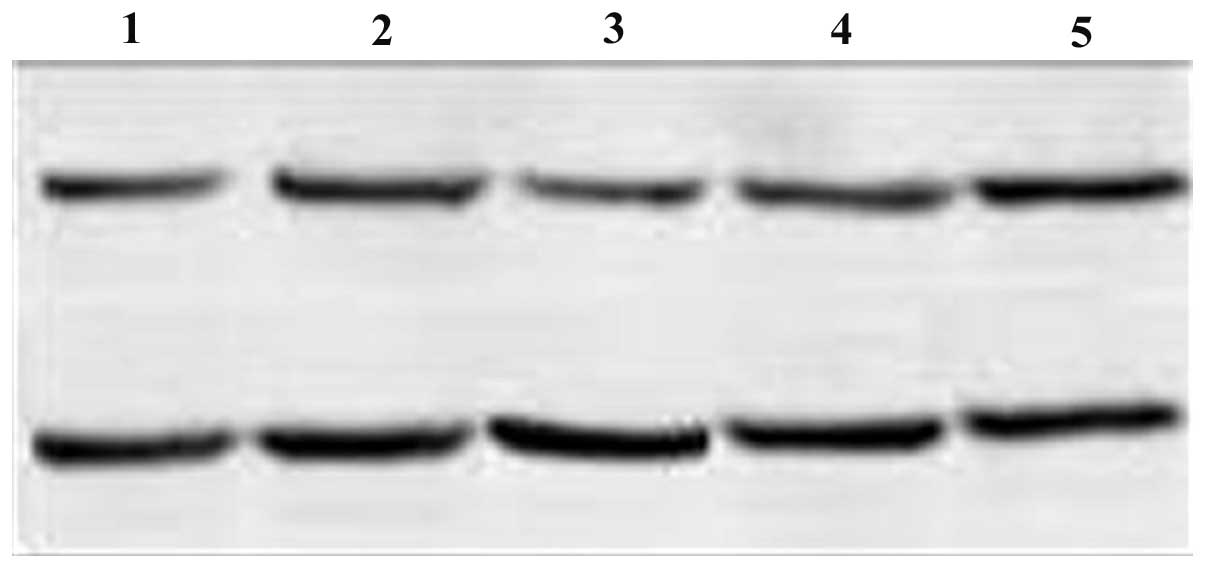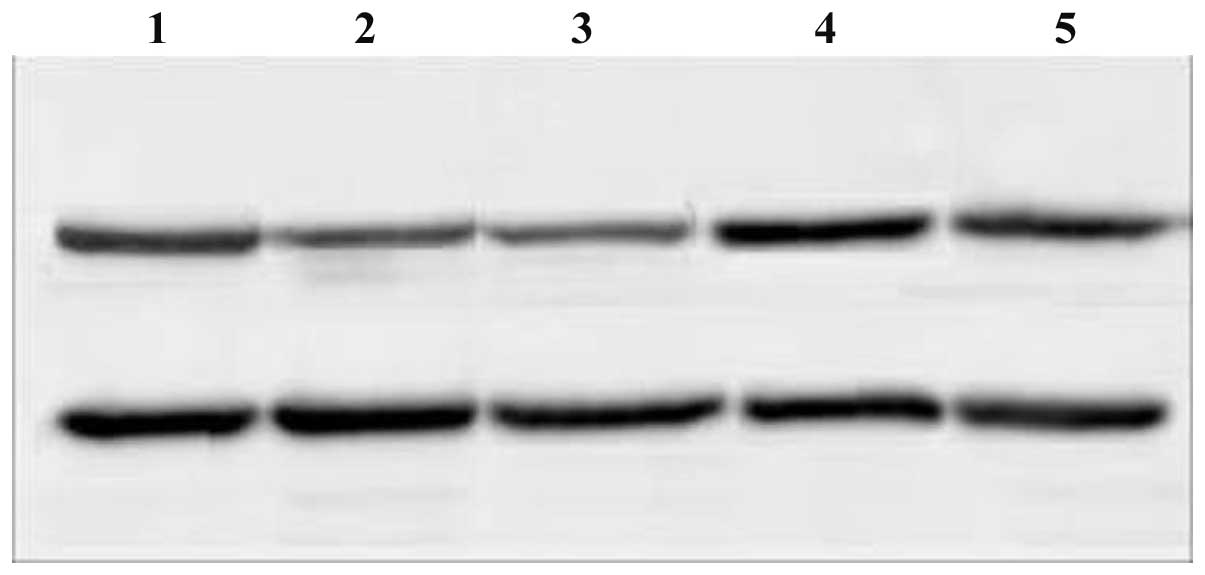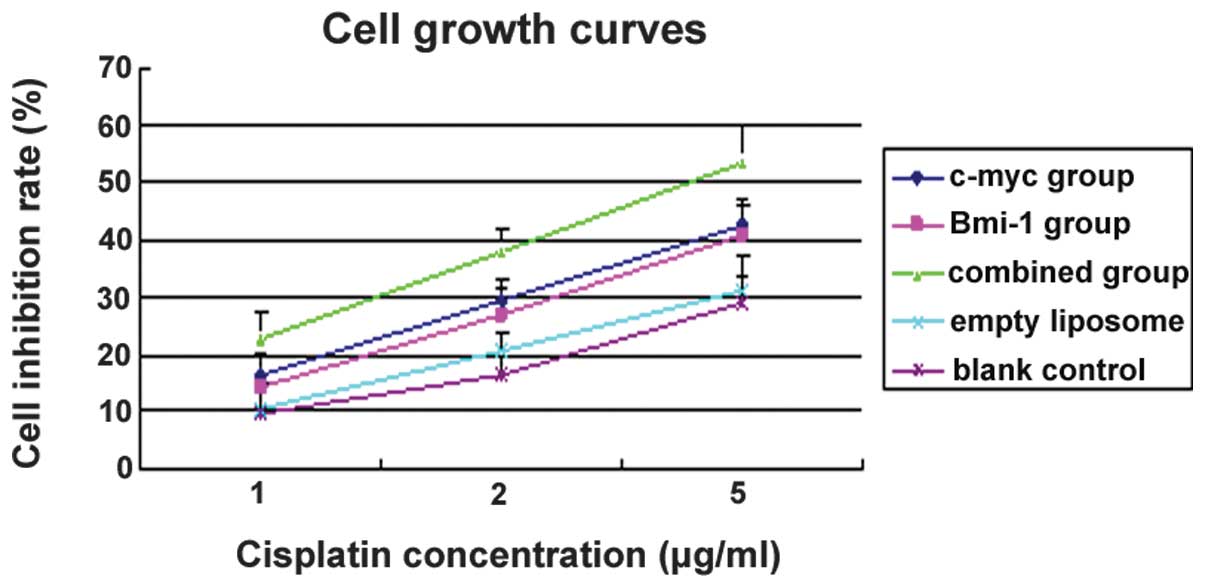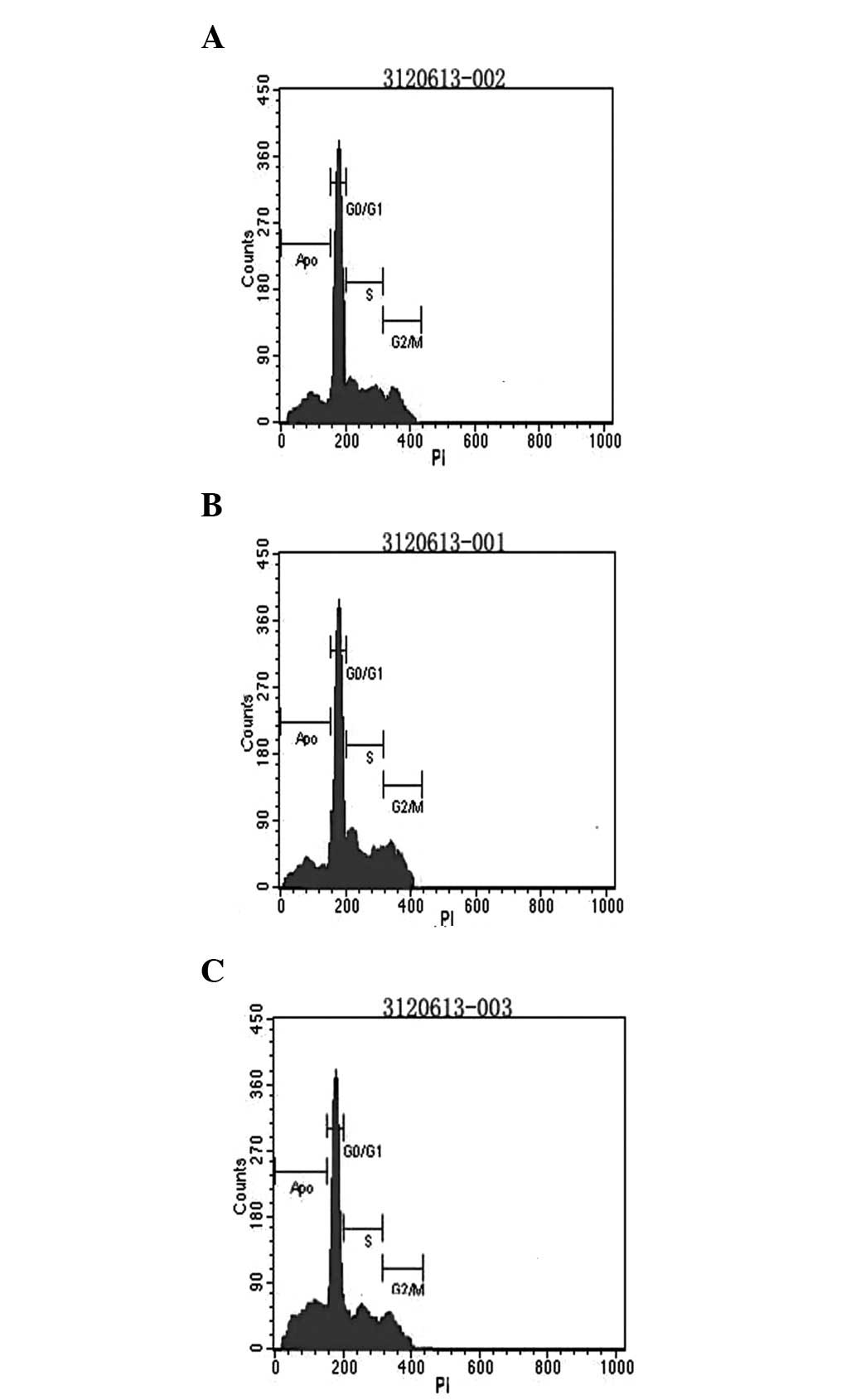Effects of combined c-myc and Bmi-1 siRNAs on the growth and chemosensitivity of MG-63 osteosarcoma cells
- Authors:
- Published online on: May 20, 2013 https://doi.org/10.3892/mmr.2013.1484
- Pages: 168-172
Abstract
Introduction
Osteosarcoma is the most common form of primary malignant bone tumor and exhibits a high degree of malignancy. Osteosarcoma is most common in young individuals aged between 10 and 25 years. Single amputation treatment has been associated with a number of limitations, including a high disability rate and a low 5-year survival rate. Recently, the clinical application of neoadjuvant chemotherapy and surgical staging systems has been successfully used in the majority of patients with stage IIB osteosarcoma while performing limb salvage surgery; as a result of this, the 5-year survival rate has increased to 60–70% (1,2). However, patients who are insensitive to chemotherapy continue to have a poor prognosis. Based on the results of advanced studies on tumor molecular biology and gene function, we hypothesized that differences in tumor-associated gene expression are the main cause of differences in the sensitivity to identical chemotherapeutic drugs observed between patients (3).
According to a recent study, 70% of human tumor cells exhibit c-myc overexpression, which stimulates cell proliferation, migration and invasion (4). Hattinger et al(5) confirmed that varying degrees of c-myc amplification were observed in doxorubicin and the human osteosarcoma cell lines U2OS and SAOS-2, which demonstrated methotrexate (MTX) resistance. Bmi-1 is one of the core members of the Polycomb-group (PcG) gene family. It is involved in the regulation of transcriptional repression associated with the cell cycle and cell proliferation. A reduction in Bmi-1 gene expression in glioma cells and multiple myeloma is capable of inhibiting the proliferation of tumor cells (6,7). Bmi-1 is highly expressed in Ewing's sarcoma cells. By knocking down the expression of Bmi-1, the expression of multiple downstream genes associated with the cell cycle may be regulated (8). Several studies have shown that c-myc and Bmi-1 are involved in the regulation of cell growth and the apoptotic signaling pathway. Thus, the expression of these genes determines the sensitivity of tumors to chemotherapy (9,10). A previous study investigated genes associated with the drug resistance of osteosarcoma in different patients. It was observed that reducing c-myc expression in osteosarcoma cells significantly reduced cell resistance to MTX (11). Knocking down Bmi-1 gene expression in SAOS-2 osteosarcoma cells caused inhibition of the PI3K/AKT signaling pathway, leading to the enhancement of tumor sensitivity to chemotherapy (12). In our previous study, we reported that reduced c-myc expression in MG-63 osteosarcoma cells was capable of increasing the chemosensitivity of these cells to cisplatin (CDDP) in order to induce cell apoptosis (13). Therefore, coupling of the c-myc and Bmi-1 genes may provide suitable therapeutic targets for enhancing osteosarcoma sensitivity to chemotherapy. However, it is necessary to further investigate this hypothesis, since it has not been explored by previous studies.
In the present study, MG-63 cells were transfected with the small interfering RNAs (siRNAs) c-myc and Bmi-1 separately or in combination, and the chemosensitivity to CDDP and cell proliferation and apoptotic rates were detected. The aim of this study was to investigate the combinational effects of c-myc and Bmi-1 siRNAs on osteosarcoma cell growth and chemosensitivity. These data may provide novel insights to improve our understanding of the underlying mechanisms involved in chemotherapeutic sensitivity, and aid in the development of future therapeutic strategies for the treatment of osteosarcoma.
Materials and methods
Cell culture
The human osteosarcoma MG-63 cell line was purchased from Shanghai Institute of Cell Biology (Shanghai, China). The cells were maintained in DMEM (Gibco-BRL, Carlsbad, CA, USA) supplemented with 10% FBS (Hyclone, Thermo Fisher Scientific Inc., Logan, UT, USA). The cell culture was stored at 37°C in a 5% CO2 incubator. The study was approved by the ethics committee of Second Affiliated Hospital College of Medicine, Zhejiang University, Hangzhou, China.
Transfection of c-myc and Bmi-1 siRNAs
c-myc and Bmi-1 siRNAs were purchased from Abcam Inc. (Cambridge, MA, USA). Two types of siRNA were diluted in serum-free DMEM, individually and in combination. Lipofectamine 2000 (Gibco-BRL) was diluted in RPMI-1640 medium, following incubation at room temperature for 5 min. To facilitate the formation of a siRNA/liposome complex, the two reactant solutions were mixed thoroughly and incubated at room temperature for 20 min. The dose of the siRNA/liposome complex medium was 250 μl, while the strength of siRNA was 100 pmol and that of the liposome was 5 μl. According to the experimental conditions, there were four groups: i) The c-myc siRNA group; ii) the Bmi-1 siRNA group; iii) the c-myc/Bmi-1 siRNA combination group and iv) the empty liposome group. A blank control group only contained DMEM. Synchronous transfection was conducted until the MG-63 cells had grown to an appropriate density. Three duplicate wells were prepared for each group.
RT-PCR analysis
MG-63 cells from each group were collected at 0, 24, 48 and 72 h following transfection. Total RNA was extracted using the TRIzol kit (Takara Bio, Inc., Shiga, Japan) according to the manufacturer's instructions. The concentration and purity of total RNA were detected using an UV spectrophotometer, followed by two-step RT-PCR. The amplification products of β-actin were used as an internal control. RT reaction conditions were as follows: 42°C for 60 min followed by 75°C for 10 min. PCR reaction conditions were as follows: denaturation at 94°C for 5 min; cycles were started at 94°C for 40 sec and continued at 58°C for 35 sec and 72°C for 50 sec; a total of 34 cycles were performed and the final extension cycle was at 72°C for 10 min. Electrophoresis of PCR products was conducted on 2% agarose gel. Images were captured using the Imagemaster VDS gel imaging system (Amersham Pharmacia Biotech, UK).
Western blot analysis
MG-63 cells from each group were collected 72 h after transfection. Cells were lysed with cell lysis buffer and the total protein concentration was detected using the BCA protein quantification kit (BCA Protein Assay Kit, Thermo Fisher Scientific Inc., USA). Protein (20 μg) was separated by electrophoresis on 10% polyacrylamide gel. Electrophoretic transfer was conducted for 2 h at a constant voltage of 120 V. Thereafter, the protein medium was kept at room temperature for 1 h and blocked overnight at 4°C. c-myc primary antibody at a 1:600 dilution, Bmi-1 primary antibody at a 1:800 dilution and β-actin primary antibody at a 1:1000 dilution (Invitrogen Life Technologies, Carlsbad, CA, USA) were added sequentially to the medium prior to overnight incubation at 4°C. The primary antibodies were then hybridized with secondary antibodies at room temperature for 1 h following washing of the membrane with TBST buffer. The membrane was developed using the ECL system (Amersham Pharmacia Biotech). Protein expression levels were analyzed using a gel image analysis system. Using the expression levels of β-actin as a reference, we compared the relative expression levels of c-myc and Bmi-1 proteins in all groups.
Cell growth assay
MG-63 cells were transfected with c-myc and Bmi-1 siRNAs either individually or in combination. Following 48 h of transfection, the MG-63 cells of each group were mixed with 1.0, 2.0 and 5.0 μg/ml CDDP for 2 h. Absorptiometry values (An) for each group were detected at a wavelength of 490 nm. Cell growth curves were created and the growth inhibition rate of cells was calculated using the measured An values. The cell growth inhibition rate was calculated using the following formula: Cell growth inhibition rate = [(Ac-Ae)/Ac] × 100% (Ac, absorptiometry value of the control group; Ae, absorptiometry value of the experimental group).
Flow cytometric analysis
To detect cell apoptosis, fluorescent staining was performed using the Annexin V-FITC/propidium iodide (PI) double-labeling method. Cells were treated with c-myc and Bmi-1 siRNAs for 24 h, either separately or in combination. Thereafter, 5 μg/ml CDDP was added to the cell culture and incubated for 48 h. Cells were collected and centrifuged at 300 × g for 5 min. Following removal of the supernatant, cells were resuspended in PBS. Then, 5 μl Annexin V-FITC and 5 μl PI dye (Sigma, St. Louis, MO, USA) were added to the medium. Oscillation, mixing and cold staining of this medium were then performed at 4°C for 10 min. Next, 25 μl DNA-Prep LPR (Coulter Electronics Health, USA) was added to the aforementioned double-labeled staining samples for a 10 min incubation in the dark, which were then centrifuged at 1,000 × g for 5 min. The supernatant was removed, 500 μl DNA-Prep stain (Coulter Electronics Health) was added and the staining was conducted for 15 min at room temperature away from light. Cell apoptosis and the cell cycle distribution of each group were detected by flow cytometry.
Statistical analysis
Quantitative data were expressed as the mean ± SD. Comparisons among the groups were conducted using single-factor analysis of variance. Comparisons between two groups were examined using Student's t-test. P<0.05 was considered to indicate a statistically significant difference. All data were analyzed using SPSS 12.0 software (SPSS Inc., USA).
Results
siRNA downregulates c-myc and Bmi-1 gene expression
When MG-63 cells were transfected with c-myc and Bmi-1 siRNAs (either individually or in combination), c-myc and Bmi-1 mRNA expression levels gradually decreased within 72 h, as demonstrated by the RT-PCR assay. Compared with c-myc and Bmi-1 mRNA expression levels in the single siRNA groups, levels were significantly decreased in the combination siRNA group (P<0.05; Figs. 1 and 2). c-myc protein expression levels decreased in the c-myc siRNA and combination groups 72 h after transfection; the decrease in expression levels was more evident in the combination group (P<0.05). By contrast, no distinct decrease in c-myc protein expression levels was detected in the Bmi-1 siRNA and control groups (Fig. 3). Compared with the control group, Bmi-1 protein expression levels decreased in all siRNA groups (P<0.05). The most marked decrease in Bmi-1 protein expression levels was observed in the combination siRNA group. Bmi-1 protein expression levels were decreased to a greater extent in the Bmi-1 siRNA group compared with the c-myc siRNA group; a significant difference was observed between the two groups (P<0.05; Fig. 4).
Cell growth inhibitory effects
Compared with the empty liposome and blank control groups, the cell growth inhibition rates of MG-63 cells gradually increased with increasing concentrations of CDDP. This observation was consistent for the single and combined siRNA groups. The growth inhibition rate in the combination siRNA group was significantly higher than that of the single siRNA groups (P<0.05). However, no significant differences were detected between the c-myc and Bmi-1 siRNA groups (P>0.05). At a concentration of 5.0 μg/ml CDDP, the growth inhibition rates were 53.3±5.2, 42.7±6.3 and 40.9±4.7% for the combined, c-myc and Bmi-1 siRNA groups, respectively (Fig. 5). The cell growth inhibitory effects observed in the combined siRNA group were greater than those observed in the two single siRNA groups (P<0.05), indicating a significant increase in the chemosensitivity of MG-63 cells to CDDP.
Flow cytometric analysis of MG-63 cell apoptosis
The apoptotic rate and cell cycle distribution of cells were detected by flow cytometry. The apoptotic rates were 37.3±4.9, 24.8±5.6 and 22.7±6.1% in the combined, c-myc and Bmi-1 siRNA groups, respectively. The apoptotic rates of cells in these groups were markedly higher than that of the control group (P<0.05). In addition, compared with the two single siRNA groups, MG-63 cell apoptosis increased considerably in the combined siRNA group (P<0.05; Fig. 6). However, there were no significant differences in the cellular apoptotic rates between the two single siRNA groups (P>0.05).
Discussion
Tumor chemosensitivity is correlated with three important parameters; the tumor cell proliferation ratio, the cell cycle and doubling time of cell proliferation. In addition, several factors affect the sensitivity of tumor cells to chemotherapeutic agents, including disorders in drug uptake and transport, drug activation barriers, enhancement of DNA damage and repair capacity and obstacles in the apoptotic pathway (14). The effects of ATP-binding cassette (ABC) transporter proteins on tumor chemosensitivity were studied extensively in recent studies. ABC transporter proteins release energy through the hydrolysis of ATP; this energy is used to transport chemotherapeutic drugs from the inside to the outside of tumor cells. This significantly reduces the intracellular chemotherapeutic drug concentration, resulting in the resistance of tumor cells (15). However, there is currently no consensus on whether the overexpression of ABC transporter proteins in osteosarcoma may be used as an indicator to predict the effects of chemotherapy and its long-term efficacy. Previous studies have also reported that chemotherapy sensitivity or resistance is caused by the interaction of various factors (5,12,15). Therefore, identifying phenotypic indicators that determine cell chemosensitivity may provide novel insights into the underlying mechanisms of chemosensitivity. c-myc, an upstream signal, is capable of regulating the expression of ABC transporter proteins that affect the active transport of chemotherapeutic drugs from the inside to the outside of tumor cells. In addition, it may also stimulate downstream signaling pathways by regulating the transcriptional expression of downstream genes, thereby decreasing the sensitivity of tumor cells to chemotherapy (16). According to previous studies, recombinant adenovirus (Myc-AS) combined with caffeine is capable of enhancing the induction of apoptosis and the chemotherapeutic effects of CDDP on MG-63 osteosarcoma cells (13). Qin et al(17) also revealed that a decrease in the gene expression of Bmi-1 in nasopharyngeal carcinoma enhanced 5-fluorouracil-mediated apoptosis. In the present study, we demonstrated that the effects of c-myc and Bmi-1 siRNAs in combination significantly improve the chemosensitivity of MG-63 cells to CDDP compared with the single siRNA groups (P<0.05). The cell growth inhibition rates for the combined, c-myc and Bmi-1 siRNA groups were 53.3±5.2, 42.7±6.3 and 40.9±4.7%, respectively. The cell growth inhibitory effects observed in the combined siRNA group were greater than those in the two single siRNA groups (P<0.05). This indicates that the chemosensitivity of MG-63 cells to CDDP may be significantly increased.
A number of studies have reported that c-myc is important in regulating cell proliferation, differentiation and apoptosis. As an early response gene, c-myc is important in regulating the transcription of a series of target genes in a number of signal transduction pathways (18,19). Previous studies have reported that high expression levels of c-myc are able to induce osteosarcoma in mouse models. This suggests that the inhibition of c-myc expression may induce the differentiation of osteosarcoma cells into mature bone cells and significantly inhibit tumor growth (20). The Bmi-1 gene is located at 10p11.23; it contains a RING finger (RF) motif in the RF domain at the N-terminal end. The Bmi-1 gene is important in cell proliferation and tumor formation in co-ordination with c-myc. In normal cells, Bmi-1 uses different promoters to regulate the gene expression levels of p16Ink4a and p19Arf, which play important regulatory roles through the tumor suppressor protein pRb and the transcription factor p53-related cell cycle pathways, respectively (21). When the expression of Bmi-1 is inhibited, p16Ink4a expression levels increase, leading to pRB dephosphorylation. Dephosphorylated pRB inhibits E2F-mediated gene transcription as a result of combining with E2F, thereby causing cell cycle arrest, which promotes apoptosis. Overexpression of Bmi-1 is able to inhibit the transcription of p19Arf, thereby increasing p53 degradation. This ultimately prevents p53-mediated apoptosis (22). P53 gene mutation and deletion is often observed in osteosarcoma cells. Bmi-1 is capable of regulating tumor cell proliferation and apoptosis through several signaling pathways. In the present study, we demonstrated that c-myc and Bmi-1 mRNA expression levels decreased significantly in the combination siRNA group compared with the single siRNA groups (P<0.05). Compared with the control group, Bmi-1 protein expression levels decreased in all siRNA groups (P<0.05), with the most marked decrease being observed in the combination siRNA group. Furthermore, expression levels in the Bmi-1 siRNA group decreased to a greater extent compared with the c-myc siRNA group (P<0.05). The data demonstrated that Bmi-1 is downregulated by c-myc via an unknown mechanism. Cellular apoptotic rates for the combined, c-myc and Bmi-1 siRNA groups were 37.3±4.9, 24.8±5.6 and 22.7±6.1%, respectively. Notably, the cellular apoptotic rates of these three groups were significantly higher than that of the control group (P<0.05). In addition, compared with the two single siRNA groups, MG-63 cell apoptosis significantly increased in the combined siRNA group (P<0.05). However, there were no significant differences in cellular apoptotic rates between the two single siRNA groups (P>0.05).
In the present study, we compared the effects of single and combined c-myc and Bmi-1 siRNAs on MG-63 cells. We demonstrated that the chemosensitivity of MG-63 cells to CDDP was markedly enhanced in the siRNA combination group. A declined proliferative capacity of MG-63 cells and increased apoptosis were also observed in the siRNA combination group. This study may provide novel insights to further elucidate the pathogenesis and drug resistance mechanisms involved in osteosarcoma. It may also improve our understanding of the underlying mechanisms involved in chemotherapeutic sensitivity and aid in the development of future therapeutic strategies for the treatment of osteosarcoma.
Acknowledgements
The authors would like to thank colleagues at the Department of Orthopedics, Second Affiliated Hospital College of Medicine, Zhejiang University, for their technical assistance and helpful comments. This study was supported by a medical scientific project grant from the Bureau of Health, Zhejiang Province, China (no. 2011RCB023).
References
|
Poletajew S, Fus L and Wasiutyński A: Current concepts on pathogenesis and biology of metastatic osteosarcoma tumors. Ortop Traumatol Rehabil. 13:537–545. 2011. View Article : Google Scholar : PubMed/NCBI | |
|
Bernthal NM, Federman N, Eilber FR, Nelson SD, Eckardt JJ, Eilber FC and Tap WD: Long-term results (>25 years) of a randomized, prospective clinical trial evaluating chemotherapy in patients with high-grade, operable osteosarcoma. Cancer. 118:5888–5893. 2012. | |
|
Broadhead ML, Clark JC, Myers DE, Dass CR and Choong PF: The molecular pathogenesis of osteosarcoma: a review. Sarcoma. 2011:9592482011. View Article : Google Scholar : PubMed/NCBI | |
|
Dang CV: MYC on the path to cancer. Cell. 149:22–35. 2012. View Article : Google Scholar : PubMed/NCBI | |
|
Hattinger CM, Stoico G, Michelacci F, Pasello M, Scionti I, Remondini D, Castellani GC, Fanelli M, Scotlandi K, Picci P and Serra M: Mechanisms of gene amplification and evidence of coamplification in drug-resistant human osteosarcoma cell lines. Genes Chromosomes Cancer. 48:289–309. 2009. View Article : Google Scholar : PubMed/NCBI | |
|
Godlewski J, Nowicki MO, Bronisz A, Williams S, Otsuki A, Nuovo G, Raychaudhury A, Newton HB, Chiocca EA and Lawler S: Targeting of the Bmi-1 oncogene/stem cell renewal factor by microRNA-128 inhibits glioma proliferation and self-renewal. Cancer Res. 68:9125–9130. 2008. View Article : Google Scholar : PubMed/NCBI | |
|
Jagani Z, Wiederschain D, Loo A, He D, Mosher R, Fordjour P, Monahan J, Morrissey M, Yao YM, Lengauer C, Warmuth M, Sellers WR and Dorsch M: The Polycomb group protein Bmi-1 is essential for the growth of multiple myeloma cells. Cancer Res. 70:5528–5538. 2010. View Article : Google Scholar : PubMed/NCBI | |
|
Douglas D, Hsu JH, Hung L, Cooper A, Abdueva D, van Doorninck J, Peng G, Shimada H, Triche TJ and Lawlor ER: BMI-1 promotes ewing sarcoma tumorigenicity independent of CDKN2A repression. Cancer Res. 68:6507–6515. 2008. View Article : Google Scholar : PubMed/NCBI | |
|
Savage KJ, Johnson NA, Ben-Neriah S, Connors JM, Sehn LH, Farinha P, Horsman DE and Gascoyne RD: MYC gene rearrangements are associated with a poor prognosis in diffuse large B-cell lymphoma patients treated with R-CHOP chemotherapy. Blood. 114:3533–3537. 2009. View Article : Google Scholar : PubMed/NCBI | |
|
Qin L, Zhang X, Zhang L, Feng Y, Weng GX, Li MZ, Kong QL, Qian CN, Zeng YX, Zeng MS, Liao DF and Song LB: Downregulation of BMI-1 enhances 5-fluorouracil-induced apoptosis in nasopharyngeal carcinoma cells. Biochem Biophys Res Commun. 371:531–535. 2008. View Article : Google Scholar : PubMed/NCBI | |
|
Scionti I, Michelacci F, Pasello M, Hattinger CM, Alberghini M, Manara MC, Bacci G, Ferrari S, Scotlandi K, Picci P and Serra M: Clinical impact of the methotrexate resistance-associated genes C-MYC and dihydrofolate reductase (DHFR) in high-grade osteosarcoma. Ann Oncol. 19:1500–1508. 2008. View Article : Google Scholar | |
|
Wu Z, Min L, Chen D, Hao D, Duan Y, Qiu G and Wang Y: Overexpression of BMI-1 promotes cell growth and resistance to cisplatin treatment in osteosarcoma. PLoS One. 6:e146482011. View Article : Google Scholar : PubMed/NCBI | |
|
Xie XK, Yang DS, Ye ZM and Tao HM: Enhancement effect of adenovirus mediated antisense C-myc and caffeine on the cytotoxicity of cisplatin in osteosarcoma cell lines. Chemotherapy. 55:433–440. 2009. View Article : Google Scholar : PubMed/NCBI | |
|
Lonning PE: Molecular basis for therapy resistance. Mol Oncol. 4:284–300. 2010. View Article : Google Scholar | |
|
Li YT, Chua MJ, Kunnath AP and Chowdhury EH: Reversing multidrug resistance in breast cancer cells by silencing ABC transporter genes with nanoparticle-facilitated delivery of target siRNAs. Int J Nanomedicine. 7:2473–2481. 2012.PubMed/NCBI | |
|
Guney I, Wu S and Sedivy JM: Reduced c-Myc signaling triggers telomere- independent senescence by regulating Bmi-1 and p16INK4a. Proc Natl Acad Sci USA. 103:3645–3650. 2006. View Article : Google Scholar : PubMed/NCBI | |
|
Qin L, Zhang X, Zhang L, Feng Y, Weng GX, Li MZ, Kong QL, Qian CN, Zeng YX, Zeng MS, Liao DF and Song LB: Downregulation of BMI-1 enhances 5-fluorouracil-induced apoptosis in nasopharyngeal carcinoma cells. Biochem Biophys Res Commun. 371:531–535. 2008. View Article : Google Scholar : PubMed/NCBI | |
|
Guney I and Sedivy JM: Cellular senescence, epigenetic switches and c-Myc. Cell Cycle. 5:2319–2323. 2006. View Article : Google Scholar : PubMed/NCBI | |
|
Lüscher B and Vervoorts J: Regulation of gene transcription by the oncoprotein MYC. Gene. 494:145–160. 2012.PubMed/NCBI | |
|
Jain M, Arvanitis C, Chu K, Dewey W, Leonhardt E, Trinh M, Sundberg CD, Bishop JM and Felsher DW: Sustained loss of a neoplastic phenotype by brief inactivation of MYC. Science. 297:102–104. 2002. View Article : Google Scholar : PubMed/NCBI | |
|
Liu YL, Jiang SX, Yang YM, Xu H, Liu JL and Wang XS: USP22 acts as an oncogene by the activation of BMI-1-mediated INK4a/ARF pathway and Akt pathway. Cell Biochem Biophys. 62:229–235. 2012. View Article : Google Scholar : PubMed/NCBI | |
|
Datta S, Hoenerhoff MJ, Bommi P, Sainger R, Guo WJ, Dimri M, Band H, Band V, Green JE and Dimri GP: Bmi-1 cooperates with H-Ras to transform human mammary epithelial cells via dysregulation of multiple growth-regulatory pathways. Cancer Res. 67:10286–10295. 2007. View Article : Google Scholar |















